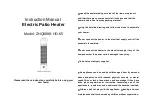
2.3 Discharge pipework
The discharge pipe (D1) from the vessel up to and
including the tundish is generally supplied by the
manufacturer of the hot water storage system.
Where otherwise, the installation should include the
dishcarge pipe(s) (D1) from the safety devise(s). In
either case the tundish should be vertical, located in
the same space as the unvented hot water storage
system and be fitted as close as possible and wihtin
500 mm of the safety device, e.g. the temperature
relief valve.
The discharge pipe (D2) from the tundish should
terminate in a safe place where there is no risk to per-
sons in the vicinity of the discharge, be of metal and:
a. be at least one pipe size larger than the nominal
outlet size of the safety device unless its total
equivalent hydraulic resistance exceeds that
of a straight pipe 9 m long, i.e. discharge pipes
between 9 m and 18 m equivalent resistance
length should be at least two sizes larger than the
miminal outlet size of the safety device, between
18 and 27 m at least three sizes larger, and so on.
Bends must be taken into account in caluclating
the flow reistance. Refer to the discharge pipe
arrangement, the copper discharge pipe table and
the worked example;
An alternative approach for sizing discharge pipes
would be to follow BS 6700:1987 Specification
for design, installation, testing and maintenance of
services supplying water for domestic use within
buildings and their curtilages, Appendix E, section
E2 and table 21.
b. have a vertical section of pipe at least 300 mm
long, below the tundish before any elbows or
bends in the pipework;
c. be installed with a continuous fall;
d. have discharges visible at both the tundish and the
final point of discharge but where this is not pos-
sible or is practically difficult there should be clear
visibility at one or other of these locations. Exam-
ples of acceptable discharge arrangements are:
i. ideally below a fixed grating and above the water
seal in a trapped gully;
ii. downward discharges at low level, i.e. up to 100
mm above external surfaces such as car parks,
hard standings, grassed areas, etc. are accpeta-
ble provided that where children may play or
otherwise come into contact with discharges a
wire cage or similar guard is positioned to prevent
contact, whilst maintaining visibility;
iii. discharges at high level, e.g. into a metal hop-
per and metal down pipe with the end of the
discharge pipe clearly visible (tundish visible or
not) or onto a roof capable of withstanding high
temperature discharges of water and 3 m from
any plastic guttering system that would collect
such discharges (tundish visible);
iv. where a single pipe serves a number of discharg-
es, such as in blocks of flats, the number served
should be limited to no more than 6 systems so
that any installation discharging can be traced
reasonably easily. The single common discharge
pipe should be at least one pipe size larger than
the largest individual discharge pipe (D2) to be
connected. If unvented hot water storage systems
are installed where discharges from safety
devices may not be apparent, i.e. in the dwell-
ings occupied by blind, infirm or disabled people,
consideration should be given to the installation
of an electronically operated device to warn when
discharge takes place.
NOTE:
the discharge will consist of scalding water
and steam. Asphalt, roofing felt and non-metal-
lic rainwater goods may be damaged by such
discharges.
SECTION I: TANK INSTALLATION
SECTION I: TANK INSTALLATION
7 VELUX
Содержание TFF 200
Страница 16: ......
Страница 26: ...26 VELUX...








































